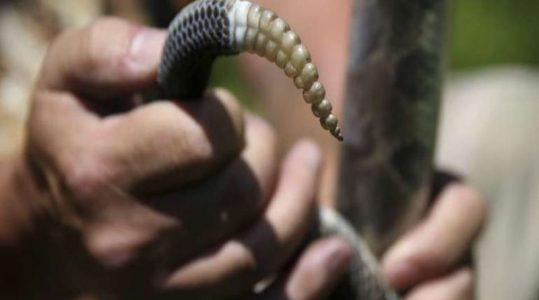
‘Kill the infidels’ with snakes and wild animals – lone ISIS terrorist told
An ISIS-allied media group is pushing lone jihadists to launch attacks employing unique methods including poisonous snakes, electrocution and ferocious animals.
The al-Ansar Media Foundation message, spelled out over the backdrop of a shadowy hooded figure, directs the “lone lion” to “kill the infidels in ways which no one else ever used.”
Suggestions listed are “snake,” “smoke,” “poison,” “wild animals,” “poisoned arrow,” “killing gaz [sp],” and “electricity.”
Before the holidays, al-Ansar circulated an image depicting a bag of “Christmas Gifts” with images of a knife attack, vehicle attack and bomb coming out of the bag.
The group also promoted arson as wildfires ripped through California in November, distributing a photo of a burning building and misspelling the state “kalifornia.”
“O america, This is the punishment of bombing Muslims in Syria,” stated the text. “This is Allah’s punishment for you. And in shaa Allah, you will see more fires. Praise be to Allah.”
They aren’t the only ISIS-supporting media group that has been encouraging jihadists to try out-of-the-box tactics, though suggesting terrorists wield wild animals is new.
Before the Nov. 9 knife attack in Melbourne, jihadists were encouraged to concentrate on poisoning Australia’s food supplies.
At the height of Australia’s strawberry contamination crisis in September — when more than 100 reports of needles found inserted into the berries resulted in growers disposing of their crops — some theorized a disgruntled employee at a packing house may have been responsible, but the case is still open. ISIS never claimed responsibility for poking needles into the strawberries, but late that month jihadists seized upon the crisis to encourage bioterror.
“O Crusaders! We will never allow you to enjoy the taste of what you desire,” said one poster distributed by ISIS supporters, including a drawing of a small bottle of poison and a photo of a fruit bowl containing grapes, apples and oranges.
Another poster with the same message bore the word “Australia” with a photo of a man in a T-shirt clutching his stomach.
“O Crusaders, We will make you check everything and anything you eat out of fear, horror and terror,” said another image of strawberries, a bottle marked “poison,” and a photo of the Sydney Opera House.
In July, Al-Faqir, a prolific ISIS media group that last month threatened grenade attacks at music venues, released a video titled “Bio Terror” that walked supporters through how to wage a bioattack on the West “that cannot be detected or tracked.”
“Sprinkle the liquid substances or the basics of bacteria with drinking water to take effect automatically,” the video advised would-be jihadists. “Sprinkle the crushed material on exposed fruit and public foods or scatter them in the air in crowded places — with caution.”
In 2016, an ISIS guide directed lone jihadists to construct explosives from “simple things” like rat poison and use poisonous plants to inflict casualties by exploring the wide range of toxins that are “accessible to everyone.”
That includes Atropa belladonna, also known as deadly nightshade, with a note that jihadists can commonly find it in home gardens because of its “beautiful shape.” Solanum dulcamara, or bitter nightshade, which is native to Europe and Asia and invasive in North America, is recommended for its “troublesome properties” — but the ISIS guide notes it’s “a rare reason of death.”
Jihadists were also advised to be on the watch for Hyoscyamus niger, known as henbane or stinking nightshade. “The entire plant is extremely toxic… used sometimes in the commission of crimes,” stated the guide. Laburnum anagyroides, or the golden chain tree, was another recommended botanical poison, as well as the native British Taxus baccata, or English yew.
Source: PJM





